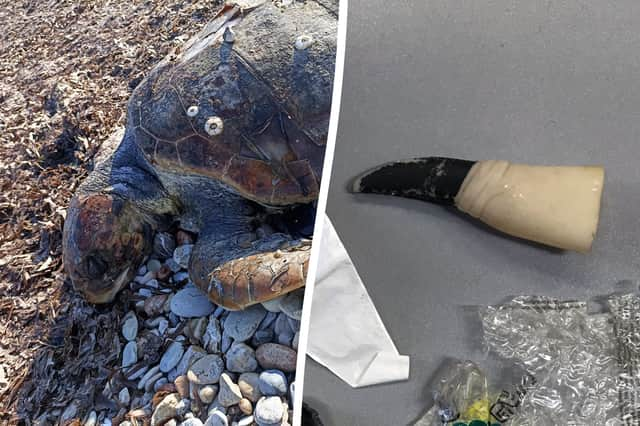Plastic pollution: Halloween 'witch's finger' among hundreds of plastic pieces found inside dead sea turtles


Researchers have found hundreds of pieces of plastic waste inside dead sea turtle stomachs - including a Halloween witch's finger toy.
In a new study - led by the University of Exeter and the North Cyprus Society for the Protection of Turtles and published this week in the Marine Pollution Bulletin - researchers examined the bodies of 135 dead loggerhead turtles. All had had either washed up on beaches or had been killed as accidental 'bycatch' in fishing nets, off northern Cyprus.
Advertisement
Hide AdAdvertisement
Hide AdThey discovered that more than 40% of the turtles had ingested 'macroplastics' (or pieces of plastic larger than 5mm), which included bottle tops and the Halloween toy - thought to be from a child's costume. Experts told SWNS it was probably eaten by the animal after it mistook it for a crab's claw.
The turtles in the study were found over ten years, from 2012 to 2022, but the rate at which they seemed to be ingesting plastics had remained stable. The research team said that loggerhead turtles were a potential bioindicator species, which could help them understand the scale and impact of plastic pollution on wildlife as a whole.
Dr Emily Duncan, from Exeter's Centre for Ecology and Conservation said: "The journey of that Halloween toy - from a child’s costume to the inside of a sea turtle - is a fascinating glimpse into the life cycle of plastic. These turtles feed on gelatinous prey such as jellyfish and seabed prey such as crustaceans, and it’s easy to see how this item might have looked like a crab claw."
The study found a total of 492 plastic pieces - including 67 inside of a single turtle. They seemed to show a "strong selectivity" towards certain types, colours and shapes of plastic - in particular, ones that resembled their favourite foods.
Advertisement
Hide AdAdvertisement
Hide AdThe most common plastic pieces researchers found were largely sheet-like (62%), clear (41%) or white (25%), and were made of polypropylene (37%) or polyethylene (35%). Dr Duncan continued: "It’s likely that turtles ingest the plastics that mostly closely resemble their foods. We still don’t know the full impacts of macroplastic on turtles’ health, but negative effects could include causing blockages and limiting nutrition."
Researchers said while the study provided vital information about plastic pollution in the eastern Mediterranean, more research was now needed more than ever - including on different species - to fully understand the impact plastic pollution was having on marine life.
Some of the impacts of plastic pollution on marine life have become better understood in recent years, with a number of high-profile and tragic cases the world over. This week, New Zealand's Department of Conservation announced that a ten-day-old toroa - or northern royal albatross chick - at a major nesting site had died from eating soft plastic regurgitated by its parent.
This was the first death of its kind at the colony, the Department said in a social media post, but it was not unexpected - with its experts finding plastic in almost all toroa chick regurgitations last season. "As algae can grow on plastic, making it small like food, the adult birds get encouraged to eat it. As well as being a risk for chicks, it can also kill adult birds because it sits in the stomach and they can’t digest it, causing dehydration or starvation." they said.
"This heartbreaking incident is a reminder that it’s vital to dispose of plastic rubbish carefully and that our actions no matter how small, can have profound consequences."
Comment Guidelines
National World encourages reader discussion on our stories. User feedback, insights and back-and-forth exchanges add a rich layer of context to reporting. Please review our Community Guidelines before commenting.
